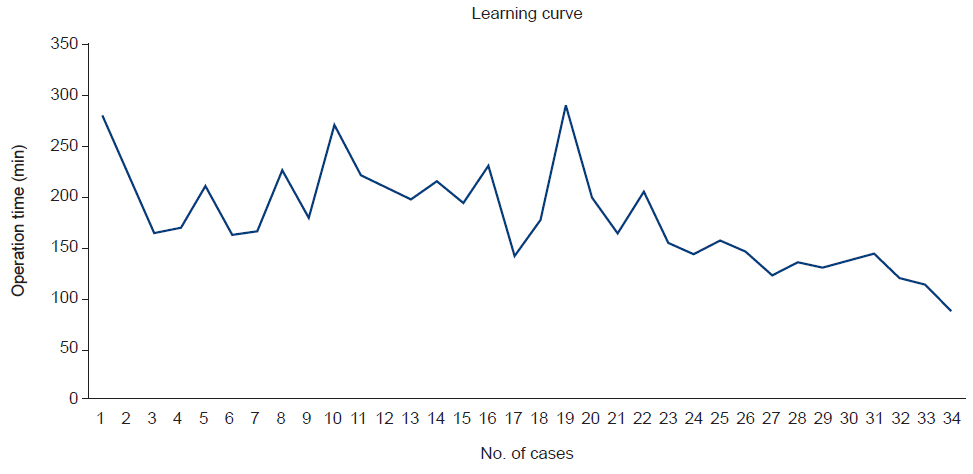Kosin Med J.
2023 Dec;38(4):267-273. 10.7180/kmj.23.143.
Initial experience with Retzius-sparing robot-assisted radical prostatectomy compared to the conventional method: is it a suitable option for robotic prostatectomy beginners?
- Affiliations
-
- 1Department of Urology, Kosin University Gospel Hospital, Kosin University College of Medicine, Busan, Korea
- KMID: 2549499
- DOI: http://doi.org/10.7180/kmj.23.143
Abstract
- Background
Retzius-sparing robot-assisted radical prostatectomy (rsRARP) is a surgical procedure that can minimize the resection of surrounding prostate tissue by enabling access through the anterior surface of the Douglas pouch. We reported our initial experiences with rsRARP compared to conventional robot-assisted radical prostatectomy (RARP).
Methods
Retrospective data were collected from March 2019 to June 2022, including 69 patients who underwent robotic radical prostatectomy for localized prostate cancer. The operations were performed at a single center, and we alternated between the two methods. Perioperative characteristics and oncologic and functional outcomes were analyzed.
Results
In total, 35 patients underwent RARP and 34 patients underwent rsRARP. The preoperative characteristics of the patients were similar. Oncologic and functional parameters were analyzed postoperatively. Except for early recovery of urinary incontinence (immediate, 1 month, 3 months, 6 months: p<0.001, p=0.002, p=0.004, and p=0.014, respectively), there were no significant differences between the two groups. We also analyzed trends in operation time and oncologic and functional outcomes according to the progression of rsRARP cases.
Conclusions
rsRARP has the major advantage of enabling an early recovery from urinary incontinence after surgery, and it is also a good surgical approach that shows oncologically similar results to the conventional approach. It is also highly reproducible and can be recommended to surgeons new to robotic radical prostatectomy.
Figure
Reference
-
References
1. Schuessler WW, Kavoussi LR, Clayman RV, et al. Laparoscopic radical prostatectomy: initial case report. J Urol. 1992; 147:246A.2. Binder J, Kramer W. Robotically-assisted laparoscopic radical prostatectomy. BJU Int. 2001; 87:408–10.3. Abbou CC, Hoznek A, Salomon L, Lobontiu A, Saint F, Cicco A, et al. Remote laparoscopic radical prostatectomy carried out with a robot: report of a case. Prog Urol. 2000; 10:520–3.4. Eastham JA, Scardino PT, Kattan MW. Predicting an optimal outcome after radical prostatectomy: the trifecta nomogram. J Urol. 2008; 179:2207–11.5. Galfano A, Ascione A, Grimaldi S, Petralia G, Strada E, Bocciardi AM. A new anatomic approach for robot-assisted laparoscopic prostatectomy: a feasibility study for completely intrafascial surgery. Eur Urol. 2010; 58:457–61.6. Lim SK, Kim KH, Shin TY, Han WK, Chung BH, Hong SJ, et al. Retzius-sparing robot-assisted laparoscopic radical prostatectomy: combining the best of retropubic and perineal approaches. BJU Int. 2014; 114:236–44.7. Menon M, Tewari A, Peabody J; VIP Team. Vattikuti Institute prostatectomy: technique. J Urol. 2003; 169:2289–92.8. Walsh PC, Donker PJ. Impotence following radical prostatectomy: insight into etiology and prevention. J Urol. 2002; 167:1005–10.9. Costello AJ, Brooks M, Cole OJ. Anatomical studies of the neurovascular bundle and cavernosal nerves. BJU Int. 2004; 94:1071–6.10. Myers RP. Detrusor apron, associated vascular plexus, and avascular plane: relevance to radical retropubic prostatectomy: anatomic and surgical commentary. Urology. 2002; 59:472–9.11. Walz J, Burnett AL, Costello AJ, Eastham JA, Graefen M, Guillonneau B, et al. A critical analysis of the current knowledge of surgical anatomy related to optimization of cancer control and preservation of continence and erection in candidates for radical prostatectomy. Eur Urol. 2010; 57:179–92.12. Stolzenburg JU, Rabenalt R, Tannapfel A, Liatsikos EN. Intrafascial nerve-sparing endoscopic extraperitoneal radical prostatectomy. Urology. 2006; 67:17–21.13. Budaus L, Isbarn H, Schlomm T, Heinzer H, Haese A, Steuber T, et al. Current technique of open intrafascial nerve-sparing retropubic prostatectomy. Eur Urol. 2009; 56:317–24.14. Galfano A, Di Trapani D, Sozzi F, Strada E, Petralia G, Bramerio M, et al. Beyond the learning curve of the Retzius-sparing approach for robot-assisted laparoscopic radical prostatectomy: oncologic and functional results of the first 200 patients with ≥ 1 year of follow-up. Eur Urol. 2013; 64:974–80.15. Dalela D, Jeong W, Prasad MA, Sood A, Abdollah F, Diaz M, et al. A pragmatic randomized controlled trial examining the impact of the Retzius-sparing approach on early urinary continence recovery after robot-assisted radical prostatectomy. Eur Urol. 2017; 72:677–85.16. Checcucci E, Veccia A, Fiori C, Amparore D, Manfredi M, Di Dio M, et al. Retzius-sparing robot-assisted radical prostatectomy vs the standard approach: a systematic review and analysis of comparative outcomes. BJU Int. 2020; 125:8–16.17. Nyarangi-Dix JN, Gortz M, Gradinarov G, Hofer L, Schutz V, Gasch C, et al. Retzius-sparing robot-assisted laparoscopic radical prostatectomy: functional and early oncologic results in aggressive and locally advanced prostate cancer. BMC Urol. 2019; 19:113.18. Umari P, Eden C, Cahill D, Rizzo M, Eden D, Sooriakumaran P. Retzius-sparing versus standard robot-assisted radical prostatectomy: a comparative prospective study of nearly 500 patients. J Urol. 2021; 205:780–90.19. Olivero A, Galfano A, Piccinelli M, Secco S, Di Trapani D, Petralia G, et al. Retzius-sparing robotic radical prostatectomy for surgeons in the learning curve: a propensity score-matching analysis. Eur Urol Focus. 2021; 7:772–8.20. Liss MA, Osann K, Canvasser N, Chu W, Chang A, Gan J, et al. Continence definition after radical prostatectomy using urinary quality of life: evaluation of patient reported validated questionnaires. J Urol. 2010; 183:1464–8.21. Hansen J, Budaus L, Spethmann J, Schlomm T, Salomon G, Rink M, et al. Assessment of rates of lymph nodes and lymph node metastases in periprostatic fat pads in a consecutive cohort treated with retropubic radical prostatectomy. Urology. 2012; 80:877–82.
- Full Text Links
- Actions
-
Cited
- CITED
-
- Close
- Share
- Similar articles
-
- Simultaneous Retzius-sparing robot-assisted radical prostatectomy and partial nephrectomy
- Nerve-sparing techniques and results in robot-assisted radical prostatectomy
- Robot-Assisted Laparoscopic Radical Prostatectomy
- Changes in Patterns of Radical Prostatectomy due to Diffusion of Robotic Surgical System: A Nationwide Study Using Health Insurance Claims Data
- Erratum: Robot-Assisted Laparoscopic Radical Prostatectomy


